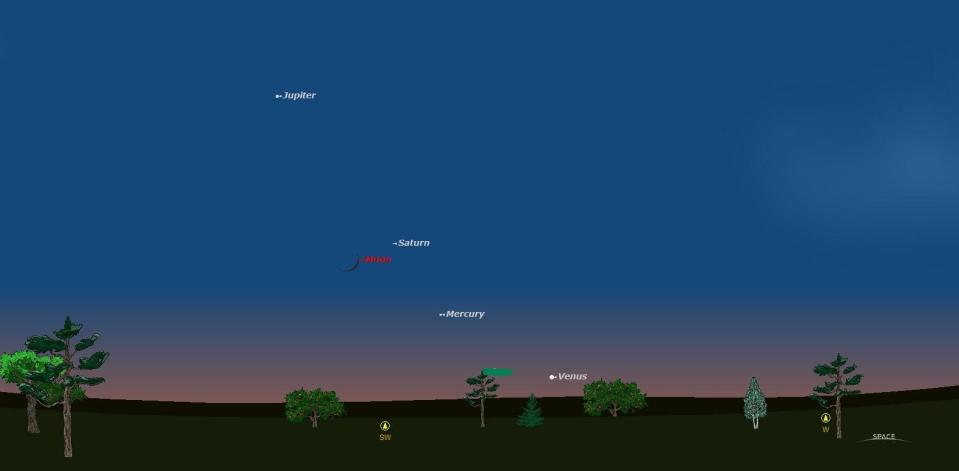Sky Shorts: Space exploration, night sky highlights for 2022
The year 2021 was certainly an exciting one for space exploration.
NASA’s Mars Exploration Rover, Perseverance, landed Feb. 18 on the surface of Mars and has collected its first sa.m.ple to return to Earth. Ingenuity, the small helicopter that hitched a ride with Perseverance, has flown 18 times on Mars. NASA SpaceX Crew 2 launched, spent time at the International Space Station and returned to Earth. Crew 3 has launched and arrived at the ISS. The most thrilling event will be the launch of the Ja.m.es Webb Space Telescope on Dec. 24, barring no other delays or problems.
Our 2021 celestial highlights included a sunrise partial solar eclipse in June, a nearly total lunar eclipse in November and the spectacular planet show in the evening sky, featuring Venus, Saturn and Jupiter!
Space exploration highlights for 2022
The Ja.m.es Webb Space Telescope will arrive at Lagrange 2, a point of gravitational equilibrium, in late January. During the trip, the 18 mirror segments will open. We expect the first image sometime this summer.
NASA”s Artemis 1 is scheduled to launch Feb. 12. This is an uncrewed flight designed to test the Space Launch System, NASA’s new powerful rocket and the Orion spacecraft. The mission of the Artemis progra.m. is to land astronauts on the Moon, including the first woman and the first person of color, by 2025.
We celebrate the 60-year anniversary of the first Earth orbit by John Glenn on Feb. 20. Glenn, one of the Mercury astronauts, orbited Earth three times in five hours, aboard Friendship 7.
NASA SpaceX Crew 3 returns in late April from the International Space Station. Crew 4 launches April 15, and Crew 5 launches in September.
JUpiter ICy moons Explorer – or JUICE – will launch in June 2022 and arrive at the Jupiter system in 2029. JUICE is designed to study three icy moons of Jupiter: Ganymede, Callisto, Europa. Each of these moons are considered to be potentially habitable.
DART – or Double Asteroid Redirection Test – will impact its target asteroid, Didymos B, in September. NASA is hoping the direct impact will slow the asteroid’s orbit.
We celebrate the 50-year anniversary of the last Apollo mission from Dec. 7-19, which was Apollo 17. Apollo 17 broke many records; longest mission, the longest spacewalk, longest lunar landing, and the largest lunar sa.m.ple brought back to Earth.
Night sky highlights for 2022:
Feb. 9 – Venus at greatest magnitude, -4.6, in the predawn sky.
April 8 – Two years until the Total Solar Eclipse.
April 30 – Venus passes 0.2 degrees south of Jupiter in the predawn sky.
May 7 – National Astronomy Day.
May 15-16 – Total lunar eclipse, begins at 10:27 p.m., maximum at 12:11 a.m. and ends at 1:55 a.m..
July 13 – Supermoon. Closest Full Moon of the year.
Nov. 8 – Total lunar eclipse. Partial eclipse begins at 4:09 a.m., maximum at 5:59 a.m. and moonset at 6:41 a.m.
Night Sky for January
Planets and the Moon
The new year starts with a spectacular line-up of planets; Jupiter, Saturn, Venus, and Mercury. The four major planets span a total of 40 degrees in the southwest. The crescent Moon dances past the line of planets for a few nights in early January. Dazzling Venus sets about an hour after sunset and shines at magnitude -4.2. Venus will drop from view after the first few days of the month. Venus will reach inferior conjunction on Jan. 8. Venus reappears in the morning sky around mid-month, rising in the east about one hour before sunrise, shining at magnitude -4.3. Visibility will improve and Venus will stand 12 degrees high before sunrise on Jan. 31. Mercury continues to climb higher in the sky and can be found slightly up and to the left of Venus on Jan. 1. Venus and Mercury will swap places the first week of January. The crescent Moon glides by Venus and Mercury on Jan. 3 and Mercury reaches greatest eastern elongation on Jan. 7. As Mercury climbs in the sky, Saturn loses altitude and the pair are closest, 3.4 degrees apart, on the evening of Jan. 12-13. By mid-month, Mercury fades and reaches inferior conjunction on Jan. 23. It returns to the morning sky the first week in February. Saturn fades out of view by the last week in January. On Jan. 4, the crescent Moon and Saturn are just 5 degrees apart, side by side. Jupiter remains visible all month and is 5 degrees north of the crescent Moon on Jan. 5. On Jan. 12, we have a dual transit of two Galileon moons, Ganymede and Callisto. Callisto’s transit begins at 5:22 p.m., followed by Ganymede at 6:50 p.m. Neptune shines at magnitude 7.8 and is located in Aquarius. Neptune lies 3.3 degrees northeast of the star Phi Aquarii. On Jan. 6, Neptune stands 8 degrees northwest of the crescent Moon and 4 degrees south on Jan. 7. Uranus resides in Aries, shining at magnitude 5.8, and lies 11 degrees southeast of Ha.m.al, the brightest star in Aries. The Moon passes 1.5 degrees south of Uranus on Jan. 11. Mars rises before 6:00 a.m. and crosses through a stunning part of the Milky Way through January and brightens to magnitude 1.4. Mars lies 6 degrees north of the star, Antares. On Jan. 29, the crescent Moon stands 3 degrees south of Mars at sunrise and they are joined by Venus which is 10.5 degrees northeast of Mars.
Constellations
East – Great star hopping in this part of the sky! Start with the most magnificent picture in our stars, Orion, the Hunter. Look for the three stars in a line, which make up the belt of Orion. The bright red-orange star up and to the left of the belt is Betelgeuse. The bright blue-white star down and to the right of the belt is Rigel. Draw a line up from the belt to a red, orange star, Aldebaran, which is the eye of Taurus, the Bull. The sideways V shape is the face of Taurus. Above Taurus, the small cluster of stars is the Pleiades or Seven Sisters. Making a counterclockwise loop from the Pleiades, the next bright star is Capella. Continuing down, the two stars you see are Gemini, the Twins.
North – The Big Dipper is beginning to swing up on its handle. Following the two stars at the end of the cup to the next bright star, is Polaris, or the North Star. The constellation Cassiopeia is above and to the left of Polaris and resembles the letter "M.”
West – There you will see four stars that form the Great Square of Pegasus.
Binocular highlights – When facing north, locate the “M” shape of Cassiopeia. From the left point of the “M” shape, scan slowly up to the left. You will see a fuzzy circular shape. That is the Andromeda Galaxy. It is 2.5 million light years away. From the right point of the “M,” scan up slightly. You will come upon the Double Cluster in Perseus. High overhead, you will see the small cluster of stars, the Pleiades or the Seven Sisters. The Pleiades is a beautiful open star cluster. Head to Orion, the Hunter. Scan below the three stars of Orion’s belt. You will see fuzzy area with bright stars. This is the Orion Nebula, a hydrogen gas cloud where new stars are forming. The peak of the Quadrantid Meteor Shower is January 3.
For further night sky details, maps and audio, visit my website www.starrytrails.com.
Visit the Hoover Price Planetarium
Visit www.mckinleymuseum.org, for show dates and times. Planetarium shows are free with museum admission. Seating is limited and will be on a first-come, first-serve basis. The Planetarium is located inside the McKinley Presidential Library & Museum, 800 McKinley Monument Drive NW, in Canton. For more information, please call the Museum at 330-455-7043.


This article originally appeared on The Repository: Sky Shorts: Space exploration, night sky highlights for 2022

